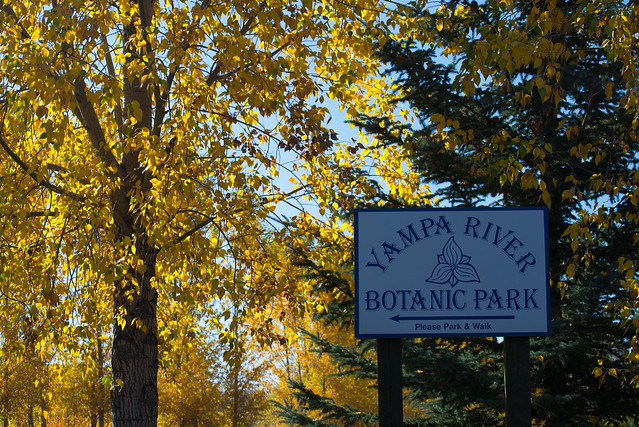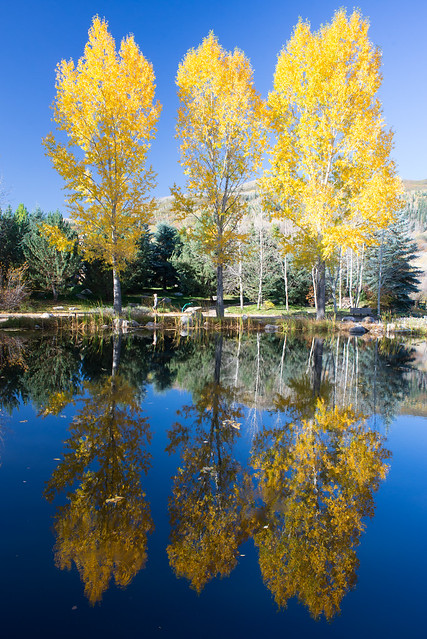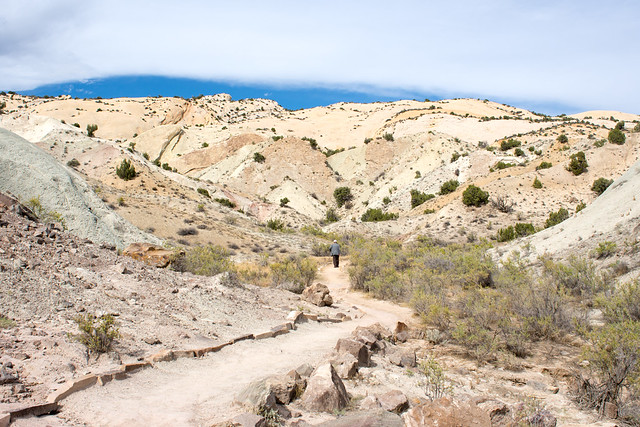Steamboat Springs, in Colorado is probably where people go skiing. There wasn't much snow about when we were there, so instead I enjoyed the hot springs at dawn. They were actually quite cool compared to Japanese hot springs, but they did include a nice swimming pool, which is not something I've ever encountered at an onsen. Other differences - the bathers were less naked but more more mixed sex. It was too expensive for both of us to enjoy this luxury so James went for a dawn run instead, upon which he met a family of moose.
The Yampa river botanical gardens exceeded expectations, and were very colourful.





--
Posted By Blogger to jules' pics at 10/20/2015
8 comments:
> Usually, in the geologic record, something the size of Stego's
> thigh bone would represent quite a long period of time.
I'd guess (you cannot possibly overestimate how completely amateur the following guess is) that you're thinking of varves, laid down in nice thin annual lake bed sedimentary layers, or limestone or dolomite, sea bed layers but probably mixed while near the surface of the seabed then buried deeper and crushed. I think whatever fell to the seabed had to be covered fairly fast -- turbidity current maybe? -- then squeezed flat.
You can still identify the contact line where dolomite is replaced by limestone or vice versa marking a relatively short time span when everything in the local ocean changed chemistry, not a year but a thingummy -- centuries? millenia? Ask Peter Ward how fast that can happen.
The nicely preserved bones are fossilized without being flattened (hey, more ways than I knew about http://www.livescience.com/37781-how-do-fossils-form-rocks.html for that to happen) in places where a body could be buried in sediment, washed downstream into a pothole that filled up -- a thick layer including the bones all accumulated at once and stayed uncompressed while the bone was replaced by minerals.
Someone who actually knows should be along to correct me.
Not bad, Hank.
What I was actually thinking is that there are almost 2 billion years of rocks exposed at the Grand Canyon that take up less than 2000m. If you made a core through Stego's fossilised thigh, would you get a single age, or a range? and what about the rock on either side of the fossil?
I'm just replying in hopes of tempting a geologist to come correct me (grin).
The big bones are fossilized in rock that hasn't been greatly compressed, I gather, from looking at http://www.nps.gov/dino/learn/nature/morrison-formation.htm
You don't see that sort of rock exposed in the Grand Canyon anywhere, and no big bones are found there. There are layers that were seashore mud, with fossils flattened into those, but smaller stuff. As I read it taking slices of a fossil in sedimentary rock would mostly get you the date the mineral material replaced the original animal material, which can come long after the surrounding rock formed.
For the big bones you need to go to an area where the rock hasn't been transformed by that much overburden compressing it.
"Mudstone" and "sandstone" are sedimentary, not hugely compressed -- pretty much as they were laid down -- so bones of animals that were rapidly buried in sediment could be replaced by the (omighod what a long list of) various ways fossils are formed. Again the dates on the fossil would be when the material was replaced.
Better help needed!
Hmmm, do you know Richard Telford? Maybe he can help.
You don’t have to explain everything
Jules, sedimentation is highly non-linear. The two billion years of sediments in the Grand Canyon has at least one 1100 million year gap, and even in the "continuous" sediments, deposition is often intermittent.
With the younger rocks up north, The Morrison formation (which holds the dinosaur bones) is mostly river sediment, so the dinosaur bones and associated sand are often flood deposits which dump a pile of sediment almost instantaneously, and then don't reoccur for tens, hundreds, maybe even thousands of years. Take the modern colorado Springs flood as an example.
Hi Chuck and others,
Thanks, that makes a lot of sense. In fact the Dinosaur bed was specifically described as probably being dumped by a flood.
Also, those places with the lovely skinny layers are necessarily complemented by other locations that have lost some part of their record to erosion.
Post a Comment